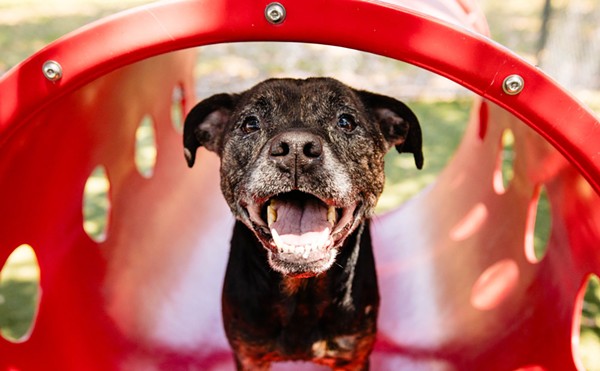The firefighters feared it was a baby. Responding to an emergency call, they heard persistent crying, but when they tracked the sound into an abandoned house, it led them to a box. Inside was not a baby but a puppy. They were relieved, but obligated to deal with it. What to do with an orphaned puppy in the middle of the night? There was only one person in Central Florida they could think to call at 1 a.m.: Judy Sarullo, founder of Pet Rescue by Judy, who keeps her phone beside her bed at night in case just such a call comes in. She’d rather lose sleep now, she says, than lose sleep later knowing that an animal didn’t get help when it needed it.
And so it was that Sarullo, who at 65 has a hard time navigating her hometown Sanford in daylight, much less a trek to Ocoee by streetlight, headed out to pick up the newest addition to her rescue fold, which includes more than 200 cats and 140 dogs.
“The police department thinks I’m their personal rescue,” Sarullo says. “I had one officer called me at 3 o’clock in the morning. … He used to come to my house when I lived in Orlando, and I’d go, ‘Where are you, officer?’ ‘I’m in front of the house, bring some cat carriers.’”
Sarullo’s demeanor is reminiscent of Lucille Ball – she’s always laughing, peculiar but driven, with a warm but brash charm and a New York accent. And though she has yet to be considered (as Ball was) for the National Women’s Hall of Fame, the Girl Scouts of America recently nominated her for their Women of Distinction award for her volunteer work with Dream Acres for Autism, where she successfully partnered two shelter dogs with autistic children in need of service dogs, as well as her day-to-day animal-welfare-driven work. “It’s such an honor,” she says of the recognition.
Another honor: that Sarullo has managed to build such immense community support for her rescue efforts that she’s gathered enough resources – including donated buildings, materials and monetary contributions – to construct the shelter of her dreams, which she hopes will be operable by October.
The $1.2 million facility, which will eventually include an animal shelter and spay/neuter clinic, is under construction now at 409 S. Laurel Ave. in Sanford. It will be the 11th space Pet Rescue by Judy has inhabited in the 21 years the organization has been rescuing animals in the Orlando area. Over the course of its lifetime, Pet Rescue by Judy – and, by extension, Sarullo herself – has been evicted, taken to court and pushed into run-down buildings without running water. Though built as a temporary care station for animals before adoption, the facility will be the first permanent residence of Pet Rescue by Judy –a place where Sarullo can, at last, truly own her cause.
Pet Rescue by Judy was founded in 1992 and made its first public appearance under a tent at an Orlando farmers market. As the small nonprofit rescue blossomed, it kept outgrowing its facilities – first Sarullo’s home, then its original location on Church Street, and next, a storefront adoption center, where Sarullo still does meet-and-greets, in the Oviedo Mall. Finally, the shelter found its way to Sanford, where she plans to stay for good.
Sarullo is an almost-accidental advocate. She originally wanted to be a vet, but her family didn’t have money for vet school. Her interest in pet rescue began when she and her husband set out to adopt a dog at an Orlando shelter in 1986. Sarullo fell for a Doberman, but her husband fell for the shelter’s oldest canine, an Old English sheepdog, who at 8 years old faced a death sentence on the coming Monday. Her husband’s insistence on adopting that particular dog resonated with Sarullo, and while she didn’t get her Doberman, she did get a new direction in life.
The sheepdog lived for eight more years, and during that time Sarullo decided she was going to personally ensure that every dog or cat she encountered would have the same opportunity for a better life. That mission has driven her for more than 20 years, thanks to a seemingly endless stream of volunteers who’ve flocked to help her. Area animal-rescue services frequently contact Sarullo to help with special-needs cases or to relieve overcrowding by taking animals that are considered highly adoptable. She helps thousands of animals per year, and though her rescue organization does charge adoption fees (which netted the organization nearly half a million dollars in revenue in 2011, according to documents on file with the IRS), she refuses to draw a salary for her work – instead, she makes sure the funding goes back to the care of the animals.
Despite the organization’s growth, though, the bills loom. And the calls keep coming in, from animal shelters as far north as Georgia and as far south as Naples. She also receives email blasts from county animal services and shelters in Seminole, Orange, Alachua and Lake counties about animals who are about to be put down. Most animal rescues in the area don’t have the resources to maintain shelters and instead operate through networks of volunteer foster homes. Many focus their efforts on a single breed. Pet Rescue by Judy takes in all breeds, ages, shapes and sizes. Her hope is that her new shelter will finally give both her and the animals room to breathe and space to grow. Orange County Animal Services takes in more than 23,000 animals annually and the Society for the Prevention of Cruelty to Animals (SPCA) of Central Florida another 14,000; Pet Rescue by Judy hopes its improved shelter facility will help make a meaningful dent in the burden on shelters that frequently have no choice but to dispose of unclaimed animals due to overcrowding.
“It’s been my dream and my hope for 21 years. Now, it’s coming to fruition,” Sarullo says. “It’s just to make the animals safe and comfortable and find them a home. … Even today – I haven’t been here, I’ve been running around for four days – and now today, to see more walls going up and all the silver on the walls, it’s just unbelievable. I mean, I’ve lived in the woods, I’ve lived in the weirdest places with the animals and now to think that they’re going to be out in fresh air, and have a nice yard, and the cats are going to be able to look out the window – it’s just something I’ve been dreaming of and now it’s here, and it’s here for the animals.”
So far, more than $600,000 in supplies, labor and cash have been donated toward the $775,000 estimated cost of the first phase of the shelter. The project was made possible in the first place by an anonymous donor who gave Sarullo’s organization the keys to two historic buildings located directly behind Sanford’s Paw Park. Sarullo says she couldn’t have asked for a better location. But on this particular construction project, dubbed Save the Tails (savethetails.com), it’s frequently not Sarullo doing the asking anyway.
Project coordinator Susan Elliott-Rink met Sarullo earlier this year the same way just about everyone does: She was looking to adopt a dog, so she visited Pet Rescue by Judy’s site. She says she isn’t normally “a cat person,” but she was, oddly, drawn to a picture of a pair of kittens. It was perhaps this decision, against her typical nature, that opened her up to other lifestyle changes, including putting her career as a business executive earning a six-figure salary on pause so she could manage Save the Tails for a year pro bono. The work has brought her into a close partnership with Sarullo, who taught Elliott-Rink how to keep a cool head and run a successful pet rescue.
“I would get attached, and then they’d get adopted, and I’d cry, ‘I’m gonna miss him!’” Elliott-Rink says of the animals who visit the Save the Tails construction site office. “And Judy’s like, ‘Nope, there’s a new one to love. On to the next one.’”
To build the shelter, which she wants to finish entirely before she moves on to build out the spay/neuter clinic next door, Elliott-Rink has brought in top-of-the-line experts, mostly friends she met while working for general contracting firm the EDC Group. Not only is she unafraid to ask for what the shelter needs, usually at no cost, she also has the balls to demand that the request be filled by the next day.
Some things can and have been donated: PVC pipes, electrical wiring, concrete. Other things are acquired at cost – the air conditioning they plan to install would cost $50,000 ordinarily, but the shelter will pay $8,600 for it, once they receive those funds. But that’s still $8,600 – a lot of money for a small community-based nonprofit – and Elliott-Rink chases the funds down as persistently as the donated supplies. The biggest financial drain, in terms of actual cash, however, is not construction expense. It’s the costs imposed by the city: impact fees, tapping into the sewer, connecting to the main line for water for a fire-suppression system. No amount of sweet-talking or cause-convincing, or even begging, can budge a city into discounts or waived fees.
“I understand that, politically, it’s impossible for them,” Elliott-Rink says. “They can’t do anything for Judy’s organization that they’re not willing to do for the other 450 nonprofits that exist in Sanford, and Sanford has the highest per capita nonprofit/churches/community-based organizations in the state.”
Click the photo to see a gallery of photos from the Save the Tails construction site:

Cash donations still trickle in, small and large, mostly generated from adoptive pet parents visiting the Save the Tails site, but the project still needs at least one more major donor to stay on track for an October opening. Because Sarullo must also keep her current facility in Sanford up and running until the new one is completed, money is tight and bill payments are sometimes delayed.
“You know, we watch every penny, but there are only so many pennies to go around,” Sarullo says.
Principal among Sarullo’s biggest priorities, in terms of elevating the quality of life at her new shelter, lies directly underfoot: the floor. Most people wouldn’t think twice about differentiating one concrete floor from another, but Sarullo insists that the surface must be done right, and that meant first laying a new concrete foundation.
“There were two things [Judy] said to me when I first started,” Elliott-Rink says. “One was, ‘I will not compromise on the fire suppression – I don’t care what it costs – I’m gonna have those animals protected.’ And, ‘I’m not going to compromise on the floor.’”
“Thousands of animals will go through it, that’s why the floors are so imperative, because my floor right now is disgusting,” Sarullo says. “We can’t make that mistake. It’s got to be something that’s going to last, not have any disease and have a nice atmosphere for when people walk in.”
Now that the concrete is down, Sarullo says the shelter needs hospital-quality sealant to coat it. It must be able to withstand daily sanitizing without deteriorating, which is a problem with more pedestrian sealants. Elliott-Rink has consulted with HuntonBrady Architects, who designed the new 15-story tower at Florida Hospital, to see what they can come up with, and she’s optimistic they’ll find the right sealant for the job. She’s less certain how to pay for it.
Likewise, Sarullo requires the installation of a quality fire-suppression system, which she insists upon after witnessing the aftermath of a deadly blaze that swept through the Seminole County Animal Services shelter in 2007. A faulty extension cord caused a fire that killed 32 cats and seven dogs. Rather than have something like that happen at her shelter, Sarullo says she’ll tack another $21,000 onto the project’s cost to ensure that the animals she houses are protected.
Pet Rescue by Judy’s new shelter will also have soundproof walls separating the cats from the dogs, to reduce stress from foreign sounds not associated with sights. There will be a conference room where Sarullo can educate visitors and consult with vet techs and clients. An open room with high ceilings and broad windows will give the cats spaces to perch and lounge in ways they can’t in their current shelter environments. The construction crews, Sarullo says, have made suggestions for small improvements for the animals as well. Because this is a volunteer-based project, the sense of ownership and accomplishment already feels shared between Sarullo, the volunteers and the workers.
It certainly helps Save the Tails that Elliott-Rink is well-connected and well-educated enough to oversee the day-to-day while Sarullo manages the operations of the rescue organization.
“It’s not so much who I am,” Elliott-Rink says when asked how the organization has managed to attract such sophisticated attention from engineers, architects and even the city inspector of Sanford, Jon Davis, who checks in two or three times a week to coach Elliott-Rink and keep an eye out for potential hazards. “It’s who she is and what she stands for.”
Davis’ wife bakes them cookies. (Sarullo likes the peanut butter ones best.) A construction worker interrupts to inquire about yesterday’s project, laying a new line to tap into the sewer system. Elliott-Rink quibbles with him because nobody on site could answer her questions, and the worker responds to her mother-henning of the project with a nervous chuckle and genial protests. He’s in school and had an important exam that day. Any other time he’d have answered his phone. You can tell he means it, and even through what Elliott-Rink fully admits is her bitching, his response echoes the sentiment of the community when it comes to the facility’s needs being met: “I hear you, and I’m going to take care of it.”
“I know you will,” Sarullo says. “I trust you guys.”
On the day the concrete floor was poured, a mother dog who arrived days earlier from a high-kill shelter started pushing out her puppies. Excited, Sarullo flitted about the construction site proclaiming to the workers: “You’re all fathers! You’re all fathers!” The puppies were named for each construction company working on the project, and when it came time to adopt, not a single company could part with their pup. Now they all have company dogs. They say Sarullo has a knack for finding animals the right home, but her dedication to the animals reminds people that responsibilities don’t have to be dreary. And if you don’t have time for a pet project – or a pet – don’t take one on.
“Everyone has to fill out an application,” Sarullo says of her typical adoption process, which is more comprehensive than some shelters and rescues. “I have to know where they live, who they are, who’s going to be around the animals, who their vets are, and sometimes it just doesn’t work out, where it’s just not a good fit for the animal or the person. Sometimes the animal doesn’t fit with the lifestyle. I tell ’em: If you’re a couch potato, don’t get an Irish setter, and if you’re a runner, don’t get a basset hound.”
Elliott-Rink estimates the organization still needs $161,000 to complete the shelter. Interested parties and potential donors can contact her through the Save the Tails website, which includes a list of all of the project’s sponsors and donors.
“You know, we had this much money, and then of course, so much has been so graciously donated in help and labor and supplies,” Sarullo says. “But we still need a lot of money, because things come up that we can’t do ourselves that we must in fact pay for. So right now, it’s hard to be trying, and even with all the money we’ve incurred and saved, like anything else: We have to have more money. We need another big donor to come in and help us with all these extra things.”
After the first phase of the shelter is complete, Sarullo plans to construct a 4,000-square-foot native Pet Rescue by Judy vet clinic, which will likely cost an additional $500,000 to complete. Sarullo and Elliott-Rink expect the clinic to be functioning by January 2014, staffed with vet techs and at least one veterinarian, whose salaries will also need to be paid. Finances for this are still uncertain. Elliott-Rink points out that Sarullo’s work helps diminish the costs of government-funded animal shelters and doesn’t benefit from state taxes, providing a valuable community service that doesn’t just manage the problem of animal overpopulation but seeks actively to prevent it.
According to the American Humane Society, nearly half the animals brought to shelters are euthanized – that’s 3.7 million abandoned animals eventually put down each year. That’s why part of Pet Rescue by Judy’s mission is to educate the public about the importance of spaying and neutering their pets, to prevent more unwanted animals from winding up on the doorsteps of rescues and shelters around the region.
Which is exactly what happened when construction first started on the new shelter: A car pulled up outside, and in full view of all the dog owners at Sanford’s Paw Park, an undernourished, diseased dog was pushed out of the vehicle, which then sped off. In Sarullo’s office, monitors provide surveillance of all sides of the building, and she saw the dog, the car and the outraged response of dog-park-goers.
“How could they do that?” people in the crowd demanded, as Sarullo took the dog into the office. Their indignation, she says, is misallocated. The dog’s owners may not have known how to care for the dog. They may not have been able to afford to feed it. But they did know where to take the dog to fix the damage. And she’s really proud of that.
“They didn’t have to bring the dog here,” Sarullo says, noting that the poor economy has led to home foreclosures and unexpected debt that pushes people to extremes, and animals are all too often discovered by police nearly starved in vacant homes.
“Now with the economy – in 20 years, I’ve never had it this bad,” Sarullo says. “People are losing their jobs, their homes, then the animal goes to the shelter or, worse, some animals get left in the house, abandoned.”
When Pet Rescue by Judy first made the move from Orlando to Sanford in 2008, Sarullo was nervous to meet her new neighbors. She advertised her grand opening at her current location on Iroquois Avenue, and hoped, as she hopes every day, that people would take notice.
“That night we had our opening night, and I was petrified, because nobody in Sanford knew who the hell I was ’cause I was over in Oviedo and Orlando,” Sarullo says. “I was so scared. I was like, ‘Oh my god, we’re gonna be sitting here, and nobody will ever come.’ That night, the grand opening had 150 people come. I was in tears.”
By now, Sanford is well aware who Sarullo is. Elliott-Rink calls her a celebrity. The support she’s had a knack for generating in each community she nestles into has given unexpected permanency to her organization, which started as a simple out-of-house endeavor eventually run via a niche pet-adoption website.
The website remains an essential cog in Sarullo’s adoption process. Even in the new shelter, she won’t allow traditional walkthroughs – that stereotypical cruise down a lane of caged animals is not the ideal way to meet your match. Instead, every prospective pet owner will comb the website, choose an animal based on its profile and then arrange a time to meet their potential new family member in specially designated rooms at the shelter.
During construction, Pet Rescue by Judy has encountered struggles – a rotten column, one of six main support beams, was the biggest setback so far to renovating the circa-1920s buildings donated to the cause. “We are dealing with a building that was built in 1926 and that’s had its own set of adventures,” Elliott-Rink says.
But now they’ve overcome the biggest obstacles, and the next step is resolving funding and hoping that all those pieces fall into place so the rescue can be moved into its new home before the year is out.
“We’ve been very fortunate with that, finding all the right parts,” Sarullo says, which is ironic, considering that Pet Rescue by Judy ordinarily attracts only the most downtrodden mongrels.
Click the photo above to see 52 adorable and adoptable pets rescued by Judy.




















